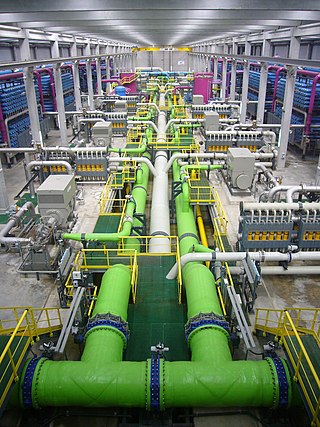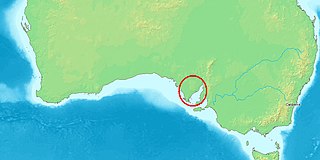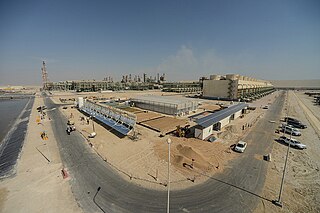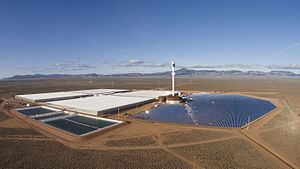
Desalination is a process that takes away mineral components from saline water. More generally, desalination is the removal of salts and minerals from a target substance, as in soil desalination, which is an issue for agriculture. Saltwater is desalinated to produce water suitable for human consumption or irrigation. The by-product of the desalination process is brine. Desalination is used on many seagoing ships and submarines. Most of the modern interest in desalination is focused on cost-effective provision of fresh water for human use. Along with recycled wastewater, it is one of the few rainfall-independent water resources.

The Spencer Gulf is the westernmost and larger of two large inlets on the southern coast of Australia, in the state of South Australia, facing the Great Australian Bight. It spans from the Cape Catastrophe and Eyre Peninsula in the west to Cape Spencer and Yorke Peninsula in the east.

Port Augusta is a small coastal city in South Australia about 310 kilometres (190 mi) by road from the state capital, Adelaide. Most of the city is on the eastern shores of Spencer Gulf, immediately south of the gulf's head, comprising the city's centre and surrounding suburbs, Stirling North, and seaside homes at Commissariat Point, Blanche Harbor and Miranda. The suburb of Port Augusta West is on the western side of the gulf on the Eyre Peninsula. Together, these localities had a population of 13,515 people in the 2021 census.
Northern Power Station was located at Port Paterson in the Australian state of South Australia about 6 kilometres (3.7 mi) south of the city centre of Port Augusta. It was coal powered with two 260 MW steam turbines that generated a total of 520 MW of electricity. It was operated and maintained by Alinta Energy and was commissioned in 1985. Northern received coal by rail from the Leigh Creek Coal Mine, 280 km to the north. The plant ceased electricity production in May 2016 and decommissioned and demolished over the following few years.
Playford B Power Station was located at Port Paterson in the Australian state of South Australia about 5.5 kilometres (3.4 mi) south of the city centre of Port Augusta. It was coal powered with four 60 MW steam turbines that generated a total of 240 MW of electricity. Playford B received coal by rail from the Leigh Creek Coal Mine, 280 km to the north and drew cooling water from Spencer Gulf, returning it to the sea at an elevated temperature. Commissioned in 1963, it was co-located with the older Playford A Power Station and the larger, newer Northern Power Station. Playford B was mothballed in 2012 and its permanent closure was announced by operator Alinta Energy in October 2015. Prior to being mothballed, it primarily operated in the summer, when electricity demand peaks.

Solar power is a major contributor to electricity supply in Australia. As of December 2023, Australia's over 3.69 million solar PV installations had a combined capacity of 34.2 GW photovoltaic (PV) solar power. In 2019, 59 solar PV projects with a combined capacity of 2,881 MW were either under construction, constructed or due to start construction having reached financial closure. Solar accounted for 12.4% of Australia's total electrical energy production in 2021.

CETO is a wave-energy technology that converts kinetic energy from ocean swell into electrical power and directly desalinates freshwater through reverse osmosis. The technology was developed and tested onshore and offshore in Fremantle, Western Australia. In early 2015 a CETO 5 production installation was commissioned and connected to the grid. As of January 2016 all the electricity generated is being purchased to contribute towards the power requirements of HMAS Stirling naval base at Garden Island, Western Australia. Some of the energy will also be used directly to desalinate water.
The Point Paterson Desalination Plant was a planned municipal-scale solar-powered desalination plant with land-based brine disposal near Point Paterson in the locality of Winninowie in the Australian state of South Australia about 13 kilometres (8.1 mi) south of the city centre of Port Augusta. The Point Paterson Project was to utilise a salt flat owned by a salt company but which has not been in use for solar salt production for decades. The plant would have integrated renewable energy and desalination technologies to create environmentally-friendly electricity and water. In particular, the project would have significantly reduced the usual greenhouse impacts associated with grid electricity demand for desalination. The project had attracted the interest of internationally renowned climatologist, the late Professor Stephen Schneider, who joined the Board of Acquasol in 2006.
A seawater greenhouse is a greenhouse structure that enables the growth of crops and the production of fresh water in arid regions. Arid regions constitute about one third of the Earth's land area. Seawater greenhouse technology aims to mitigate issues such as global water scarcity, peak water and soil becoming salted. The system uses seawater and solar energy, and has a similar structure to the pad-and-fan greenhouse, but with additional evaporators and condensers. The seawater is pumped into the greenhouse to create a cool and humid environment, the optimal conditions for the cultivation of temperate crops. The freshwater is produced in a condensed state created by the solar desalination principle, which removes salt and impurities. Finally, the remaining humidified air is expelled from the greenhouse and used to improve growing conditions for outdoor plants.

A solar power tower, also known as 'central tower' power plant or 'heliostat' power plant, is a type of solar furnace using a tower to receive focused sunlight. It uses an array of flat, movable mirrors to focus the sun's rays upon a collector tower. Concentrating Solar Power (CSP) systems are seen as one viable solution for renewable, pollution-free energy.
SolarReserve was a developer of utility-scale solar power projects which include Concentrated Solar Power (CSP) and Photovoltaic (PV) technology. The company has commercialized solar thermal energy storage technology that enables solar power tower CSP plants to deliver electricity day and night. In this technology, a molten salt is used to capture the energy from the sun and store it. When electricity is needed, the stored liquid salt is used to turn water into steam to turn a turbine and generate electricity.

eSolar is a privately held company that develops concentrating solar power (CSP) plant technology. The company was founded by the Pasadena-based business incubator Idealab in 2007 as a developer of CSP plant technology. The company aims to develop a low cost alternative to fossil fuels through a combination of small heliostats, modular architecture, and a high-precision sun-tracking system. In October 2017, an article in GreenTech Media suggested that eSolar ceased business in late 2016.

The Sahara Forest Project aims to provide fresh water, food and renewable energy in hot, arid regions as well as re-vegetating areas of uninhabited desert. The founding team was composed of Seawater Greenhouse Ltd, Exploration Architecture, Max Fordham Consulting Engineers and the Bellona Foundation.

Sierra SunTower was a 5 MW commercial concentrating solar power (CSP) plant built and operated by eSolar. The plant is located in Lancaster, California. As of mid-September, 2022, the two towers that were the center of the facility are no longer standing. However the rest of the plant is still present.

Australia is the driest habitable continent on Earth and its installed desalination capacity has been increasing. Until a few decades ago, Australia met its demands for water by drawing freshwater from dams and water catchments. As a result of the water supply crisis during the severe 1997–2009 drought, state governments began building desalination plants that purify seawater using reverse osmosis technology. Approximately one percent of the world's drinkable water originates from desalination plants.
Aalborg CSP is a Danish renewable energy specialist mainly designing solutions based on concentrated solar power (CSP) technology. The company's main office is located in, Aalborg, Denmark, and they have offices in Spain, the United States, Kenya, Australia and Indonesia. Aalborg CSP has participated in projects mainly in Spain, but also in Turkey, Norway and Russia. The most current project as of 2015 is an integrated energy system located in Port Augusta, Australia. Aalborg CSP has partnered with Sundrop Farms to create a farm powered by the sun and saltwater. By using desalination, powered by the sun, it is possible to produce the water with desalinated seawater. Aalborg CSP was in 2010 given the Gazelle Award, where companies must have had a doubling of either revenue or profit in the last four years. Aalborg CSP has 56 people employed.
Port Paterson is a locality in the Australian state of South Australia located on the east coast of Spencer Gulf at the gulf's northern end about 237.4 kilometres north of the state capital of Adelaide and about 9 kilometres south of the centre of Port Augusta.
There are approximately 16,000 operational desalination plants, located across 177 countries, which generate an estimated 95 million m3/day of fresh water. Micro desalination plants operate near almost every natural gas or fracking facility in the United States. Furthermore, micro desalination facilities exist in textile, leather, food industries, etc.
The Taralga Wind Farm is a wind farm located near Taralga, New South Wales. Owned by Pacific Blue, it commenced operation in 2015.
The Port Augusta Renewable Energy Park is a combined wind and solar farm under construction south of Port Augusta in South Australia, Australia. The solar farm is planned to be at the northern end of the site, west of the Augusta Highway and south of Sundrop Farms. The wind turbines will be on both sides of the Augusta Highway, extending south as far as the road to Horrocks Pass. Construction formally started in October 2020 and is estimated to take about 18 months to complete. The total site is about 5,400 hectares.











